
Wine Culture and Information since 2002 - Volume 22
 Wine Culture and Information since 2002 - Volume 22 |
|
Contrasts of Oltrepo Pavese Riesling Spumante and Conegliano Valdobbiadene Prosecco Superiore BrutThe tasting by contrast of the summer pours into our glasses two sparkling wines produced in two territories that have always been characterized by the production of bubbles. As usual, different territories, different sparkling wines, different grapes. |
|
The scorching summer temperatures, such as those that we will probably have during this summer 2022, certainly invite us to pour sparkling wines into our glasses. Crisp, with a lashing acidity and effervescence, they are undeniably the types of wines that better than others are capable to give the promise of a moment of joyful and refreshing pleasure. In this sense, sparkling wines produced with the Charmat method seem to be more suitable for this purpose, compared to the more robust bubbles produced with the classic method. Italy certainly offers a wide choice of sparkling wines, produced with different methods, different regions and grapes. Prosecco, in its many interpretations and territories, is clearly the most famous and celebrated sparkling wine in Italy, renowned all over the world and among the main representatives of Italian enology. Of course Prosecco is not the only sparkling wine produced in this country and – without fear of contradiction – the choice is wide and rich in almost all regions. The Charmat production method – also known in Italy as Martinotti method – consists in the refermentation of a wine in a closed tank. This process – initially conceived by Federico Martinotti, later improved by Eugène Charmat, then further elaborated by Nereo Cavazzani and, in the Valdobbiadene area, by Prof. Tullio De Rosa – generally lasts three months, a period that can be further extended between six and twelve months. When the refermentation lasts about three months, this technique takes the name of “Martinotti method”, “Charmat method” or “short Charmat method”. When the period lasts for over three months, specifically between six and twelve months, it takes the name of “Cavazzani method” or “long Charmat method”. The refermentation in closed tank allows the making of a “complete” sparkling wine in decidedly shorter times than the so-called “classic method” – or refermentation in bottle – and is therefore more suitable for ready-to-drink sparkling wines and to wines produced with aromatic or semi-aromatic grapes. This method, in fact, has the benefit of enhancing the primary and secondary aromatic qualities of grapes, as well as to make lighter and more immediate sparkling wines.
|
|
Oltrepo Pavese is one of the most important wine-growing areas in Lombardy and one of the most multifaceted in Italy for the vastness of its enological offer, variety of grapes and styles of wines. In this large area in the province of Pavia, viticulture is in fact one of the most important aspects of the local economy, especially in the hilly area where there is a high concentration of wineries and vineyards. The sparkling wine production of Oltrepo Pavese represents, in fact, only a part of the enological offer of this territory, as here are also produced table and sparkling wines in relevant quantities. As regards, specifically, to the production of sparkling wines, it should be noticed the Oltrepo Pavese Metodo Classico is also produced here, recognized as a wine with Denominazione d'Origine Controllata e Garantita (Denomination of Controlled and Guaranteed Origin, DOCG) and which does not belong to the Denominazione d'Origine Controllata (Denomination of Controlled Origin, DOC) Oltrepo Pavese. The wine we will examine for our tasting by contrast – Oltrepo Pavese Riesling Spumante – in fact belongs to the second denomination and is produced with the Charmat method. The wine we are going to evaluate this month is one of the many allowed for production according to the Oltrepo Pavese disciplinary and which – in fact – includes a long list of varieties for the production of wines. Among these, we have chosen Riesling, a very noble variety of German origin, absolute glory of the Rhine Valley and which today is considered among the so-called “international” grapes. As for Oltrepo Pavese Riesling Spumante, it should be noted the disciplinary provides for the minimum use of 85% Riesling and/or Riesling Italico, while the possible remaining 15% may consist in one or more varieties among Pinot Noir, Pinot Gris and Pinot Blanc. In this regard, it should be noted the real Riesling – better known as “Riesling Renano” or “Rhine Riesling” – has no connection with what in Italy is known as Riesling Italico and which, in fact, corresponds to Welschriesling grape, whose origins are not completely clear. This variety is quite common in the vineyards of Central Europe and, in addition to having no connection with Rhine Riesling, it makes wines which are completely different from those produced with the latter.
|
||||
|
Prosecco, in its many interpretations and territories, is a wine that does not need any particular introduction. Known all over the world, the celebrated bubbles from Veneto are – undeniably – one of the most successful Italian products and not only in the wine sector. With the term prosecco today we tend to identify the wine, however, until a few years ago, this term also indicated the variety used for its production. With the aim of eliminating the confusion that had been created over the years, as well as better safeguarding the “Prosecco” brand, today the variety at the base of this wine is identified with its ancient name, that is Glera. It should also be noted that the term “prosecco” has been the origin of the enormous misunderstanding that was created around this wine, specifically the assumption that it was a wine with a basically dry taste. The more common style of this wine, not least, categorically refutes this assumption, as the majority of Prosecco is produced in the “extra-dry” style, therefore, tending to a sweet taste and not dry. Today Conegliano Valdobbiadene Prosecco Superiore is a Denominazione d'Origine Controllata e Garantita (Denomination of Controlled and Guaranteed Origin, DOCG) wine, however with the same grape and the same name – Prosecco – can also be identified other denominations as well. Of all the appellations, we have chosen Conegliano-Valdobbiadene which, in addition to being the oldest “Prosecco” appellation – the DOC was established in 1969 – is also undeniably the best known. As far as its composition is concerned, Conegliano Valdobbiadene Prosecco Superiore must be produced with at least 85% of Glera, while the possible remaining part can be represented by Verdiso, Bianchetta Trevigiana, Perera and Glera Lunga. The production provides for the sparkling process carried out both in closed tank and method of the refermentation in bottle, comprising the styles frizzante (slightly sparkling), spumante superiore (superior sparkling), Superiore di Cartizze and Rive, that is particular territorial expressions of recognized quality, currently defined in 43 distinct rive. Finally, it should be noted the majority of Conegliano Valdobbiadene Prosecco Superiore is produced with the refermentation in closed tank and usually with 100% Glera, mainly in the “extra-dry” style. The wine we will pour into the glass is however “brut”.
|
The choice of the two wines that we will pour into the glasses of our tasting by contrast, despite being labels easily available in stores, could present some difficulties. According to the respective production disciplinary, Oltrepo Pavese Riesling Spumante and Conegliano Valdobbiadene Prosecco Superiore can be produced with different varieties, although the dominant one cannot be less than 85%. In this sense, these two wines follow what is the typical trend of almost all the appellations – and not only the Italian ones – which permits, for mono-varietal wines, and in particular the case of Lombard wine, the use of different grapes. Our aim is to evaluate these two wines produced exclusively with their respective dominant varieties, therefore Riesling Renano for Oltrepo Pavese Riesling Spumante and Glera for Conegliano Valdobbiadene Prosecco Superiore Brut. We will therefore make sure the two bottles are actually produced with their respective varieties alone. As for the production technique, in both wines we will choose those produced with the refermentation in closed tank and in the brut style, therefore with a quantity of sugars lower than 12 grams per liter. The two wines are served at a temperature of 10 °C (50 °F) and poured into two tasting glasses. We can now begin the tasting by contrast of the summer, we therefore pour Oltrepo Pavese Riesling Spumante and Conegliano Valdobbiadene Prosecco Superiore Brut into their respective glasses. Let's start with the evaluation of the aspect, first examining the Lombard wine. Let's hold the glass in vertical position and observe the development of bubbles on the surface of the wine from the above. The grain of the bubbles is medium and continuous, forming a rather dense and compact crown on the inner edge of the glass. Let's now tilt the glass over a white surface and observe the base. We can see an intense and brilliant greenish yellow color and very high transparency. The nuance, observed towards the opening of the glass, confirms the greenish yellow color. Let's now pass to the evaluation of the appearance of Conegliano Valdobbiadene Prosecco Superiore Brut and, by observing from the top of the glass, we notice – also in this case – the average grain size of the bubbles which immediately move outwards forming a dense and compact crown. After tilting the glass over the white surface, the color of Conegliano Valdobbiadene Prosecco Superiore Brut is characterized by a brilliant greenish yellow hue and nuances, observed towards the opening of the glass, show the same color. Riesling Renano – as well as Riesling Italico – makes wines with an olfactory profile decidedly different from those obtained from Glera. A characteristic that, of course, we also find in their wines produced with the method of refermentation in closed tank. Riesling Renano is certainly among the most extraordinary white berried grapes, capable of creating exciting wines and with the potential to develop considerable complexity over time. Sparkling wines produced with refermentation in closed tank, however, give decidedly simpler and more immediate olfactory profiles, however no less interesting because of this. When used for the production of these wines, Riesling Renano brings out from the glass aromas of white-fleshed and exotic fruits, in particular citrus and pineapple, while also offering aromas of apple, peach, grapefruit and lemon. As for the world of flowers, Charmat sparkling wines produced with Riesling Renano are characterized by the scents of broom and, sometimes, jasmine. Glera, the main grape of Conegliano Valdobbiadene Prosecco Superiore Brut, is characterized by aromas of wisteria, broom, hawthorn and chamomile, while, as for the main representatives of the world of fruits, we can perceive pear, apple, peach, pineapple and lychees, including hints of citrus, in particular tangerine. Let's continue the tasting by contrast of Oltrepo Pavese Riesling Spumante and Conegliano Valdobbiadene Prosecco Superiore Brut, proceeding with the analysis of the olfactory profile of the Oltrepo Pavese sparkling wine. Let's hold the glass in vertical position and, without swirling, let's do the first smell in order to appreciate the opening of this wine. From the glass emerge intense and pleasing aromas of apple, pear and broom, supported by sensations recalling citrus fruits, in particular grapefruit and lemon. After having swirled the glass – an operation favoring the development of wine aromas – the profile of Oltrepo Pavese Riesling Spumante is completed with peach, plum, pineapple and sometimes jasmine. Let's now proceed with the analysis of the opening of Conegliano Valdobbiadene Prosecco Superiore Brut and, by holding the glass in vertical position, without swirling, let's do the first smell. The sparkling wine from Veneto can be appreciated for its scents of wisteria, pear and apple, as well as peach and pineapple. After having swirled the glass and proceeded to the second smell, the profile of the wine is completed with broom, hawthorn, plum, kiwi, tangerine and lychee. Let's now pass to the evaluation of the gustatory profiles of the two wines, starting, just like in the previous phases, with the Oltrepo Pavese Riesling Spumante. Let's take a sip of this wine and evaluate its attack, that is the primary gustatory sensations perceived in the mouth. This sparkling wine is immediately appreciated for its evident effervescence, well supported by a crisp acidity, finding a good balance in the moderate effect of alcohol, with a pleasing dry taste profile. In the mouth we also perceive the flavors of apple, pear, grapefruit, lemon and pineapple, therefore having a good correspondence to the nose. Let's now pass to the evaluation of the attack of Conegliano Valdobbiadene Prosecco Superiore Brut. In the mouth, also in this case, we can immediately perceive the intense effect of the effervescence, supported by the crisp acidity, with a dry gustatory profile which further accentuates the two opening sensations. Balance is reached thanks to the moderate effect of alcohol and we can also clearly perceive the flavors of pear, apple and peach, as well as kiwi and tangerine. We are now at the end of the tasting by contrast of this summer, and therefore we proceed with the evaluation of the taste-olfactory persistence of the two wines, that is the organoleptic qualities persisting in the mouth after swallowing in function of the time. The finish of Oltrepo Pavese Riesling Spumante is of good persistence and in the mouth both the effects of acidity and effervescence continue to be clearly perceived, while the contribution of alcohol tends to quickly fade away. In the mouth we can still perceive the flavors of apple, pear, lemon and pineapple. The finish of Conegliano Valdobbiadene Prosecco Superiore Brut is persistent and, compared to the previous wine, the sensation perceived in the mouth is more round and creamy, with the sensations of acidity and effervescence still clearly perceptible. Also in this case the effect of alcohol tends to quickly fade away, however leaving the scene to the flavors of pear, apple, peach and tangerine.
|
||||||||
Wines of the Month |
|
|
|
Score legend Prices are to be considered as indicative. Prices may vary according to the country or the shop where wines are bought |

|
|
Alto Adige Sauvignon Lafoa 2020 |
|
| Produttori Colterenzio (Alto Adige, Italy) | |
 Sauvignon Blanc Sauvignon Blanc | |
| Price: € 24.50 | Score: |
 Intense greenish yellow and nuances of greenish yellow, very
transparent. Intense greenish yellow and nuances of greenish yellow, very
transparent.
 Intense, clean, pleasing, refined and elegant, starts with hints of
gooseberry, apple and elder flower followed by aromas of box flower, yellow
rose, pineapple, pear, grapefruit, peach, lychee, citrus fruits, tomato
leaf, green bell pepper, ginger and mineral. Intense, clean, pleasing, refined and elegant, starts with hints of
gooseberry, apple and elder flower followed by aromas of box flower, yellow
rose, pineapple, pear, grapefruit, peach, lychee, citrus fruits, tomato
leaf, green bell pepper, ginger and mineral.
 Crisp attack and however balanced by alcohol, good body, intense
flavors, agreeable. Crisp attack and however balanced by alcohol, good body, intense
flavors, agreeable.
 Persistent finish with flavors of gooseberry, apple and pineapple. Persistent finish with flavors of gooseberry, apple and pineapple. Part of the wine ferments in barrique. Aged for 8 months. Part of the wine ferments in barrique. Aged for 8 months. |
|
 Pasta with fish, Sauteed white meat, Stewed fish, Mushroom soups, Fried fish Pasta with fish, Sauteed white meat, Stewed fish, Mushroom soups, Fried fish |
|

|
|
Alto Adige Chardonnay Lafoa 2020 |
|
| Produttori Colterenzio (Alto Adige, Italy) | |
 Chardonnay Chardonnay | |
| Price: € 24.50 | Score: |
 Brilliant straw yellow and nuances of straw yellow, very transparent. Brilliant straw yellow and nuances of straw yellow, very transparent. Intense, clean, pleasing, refined and elegant, starts with hints of
banana, apple and acacia followed by aromas of citron, pear, melon, peach,
grapefruit, mango, plum, praline, honey, butter and vanilla. Intense, clean, pleasing, refined and elegant, starts with hints of
banana, apple and acacia followed by aromas of citron, pear, melon, peach,
grapefruit, mango, plum, praline, honey, butter and vanilla.
 Crisp attack and however balanced by alcohol, good body, intense
flavors, pleasing roundness. Crisp attack and however balanced by alcohol, good body, intense
flavors, pleasing roundness.
 Persistent finish with flavors of banana, apple and citron. Persistent finish with flavors of banana, apple and citron. 10 months in barrique, 6 months in bottle. 10 months in barrique, 6 months in bottle. |
|
 Stuffed pasta with fish, Broiled fish, Roasted fish, Roasted white meat Stuffed pasta with fish, Broiled fish, Roasted fish, Roasted white meat |
|
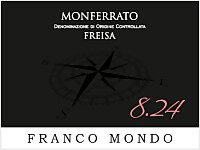
|
|
Monferrato Freisa 8.24 2019 |
|
| Franco Mondo (Piedmont, Italy) | |
 Freisa Freisa | |
| Price: € 29.00 | Score: |
 Intense ruby red and nuances of garnet red, little transparency. Intense ruby red and nuances of garnet red, little transparency. Intense, clean, pleasing and refined, starts with hints of cherry, plum
ans strawberry followed by aromas of violet, carnation, blueberry,
chocolate, carob, cinnamon, vanilla and menthol. Intense, clean, pleasing and refined, starts with hints of cherry, plum
ans strawberry followed by aromas of violet, carnation, blueberry,
chocolate, carob, cinnamon, vanilla and menthol.
 Properly tannic attack and however balanced by alcohol, good body,
intense flavors, agreeable. Properly tannic attack and however balanced by alcohol, good body,
intense flavors, agreeable.
 Persistent finish with flavors of cherry, plum and strawberry. Persistent finish with flavors of cherry, plum and strawberry. 12 months in cask, 6 months in bottle. 12 months in cask, 6 months in bottle. |
|
 Stuffed pasta with mushrooms, Stewed meat with mushrooms, Roasted meat, Cheese Stuffed pasta with mushrooms, Stewed meat with mushrooms, Roasted meat, Cheese |
|
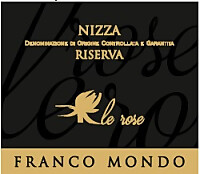
|
|
Nizza Riserva Le Rose 2016 |
|
| Franco Mondo (Piedmont, Italy) | |
 Barbera Barbera | |
| Price: € 37.00 | Score: |
 Deep ruby red and nuances of garnet red, little transparency. Deep ruby red and nuances of garnet red, little transparency. Intense, clean, pleasing, refined and elegant, starts with hints of
cherry, plum and dried violet followed by aromas of blueberry, blackberry,
cocoa, tobacco, cinnamon, leather, licorice, mace, vanilla and menthol. Intense, clean, pleasing, refined and elegant, starts with hints of
cherry, plum and dried violet followed by aromas of blueberry, blackberry,
cocoa, tobacco, cinnamon, leather, licorice, mace, vanilla and menthol.
 Properly tannic attack and however balanced by alcohol, full body,
intense flavors, pleasing roundness. Properly tannic attack and however balanced by alcohol, full body,
intense flavors, pleasing roundness.
 Persistent finish with flavors of cherry, plum and blueberry. Persistent finish with flavors of cherry, plum and blueberry. At least 36 months in cask, 12 months in bottle. At least 36 months in cask, 12 months in bottle. |
|
 Broiled meat and barbecue, Roasted meat, Stewed meat with mushrooms, Hard cheese Broiled meat and barbecue, Roasted meat, Stewed meat with mushrooms, Hard cheese |
|
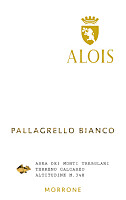
|
|
Morrone 2018 |
|
| Alois (Campania, Italy) | |
 Pallagrello Bianco Pallagrello Bianco | |
| Price: € 48.80 | Score: |
 Brilliant straw yellow and nuances of straw yellow, very transparent. Brilliant straw yellow and nuances of straw yellow, very transparent. Intense, clean, pleasing, refined and elegant, starts with hints of
apple, peach and tangerine followed by aromas of hawthorn, chamomile,
broom, citron, quince, pear, plum, pineapple, honey and hints of vanilla. Intense, clean, pleasing, refined and elegant, starts with hints of
apple, peach and tangerine followed by aromas of hawthorn, chamomile,
broom, citron, quince, pear, plum, pineapple, honey and hints of vanilla.
 Crisp attack and however balanced by alcohol, good body, intense
flavors, pleasing roundness. Crisp attack and however balanced by alcohol, good body, intense
flavors, pleasing roundness.
 Persistent finish with flavors of apple, peach and tangerine. Persistent finish with flavors of apple, peach and tangerine. 10 months in cask and steel tanks, 12 months in bottle. 10 months in cask and steel tanks, 12 months in bottle. |
|
 Stuffed pasta with fish, Roasted white meat, Roasted fish, Mushroom soups Stuffed pasta with fish, Roasted white meat, Roasted fish, Mushroom soups |
|
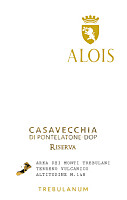
|
|
Casavecchia di Pontelatone Riserva Trebulanum 2017 |
|
| Alois (Campania, Italy) | |
 Casavecchia Casavecchia | |
| Price: € 63.50 | Score: |
 Deep ruby red and nuances of garnet red, little transparency. Deep ruby red and nuances of garnet red, little transparency. Intense, clean, pleasing, refined and elegant, starts with hints of
black cherry, blueberry and plum followed by aromas of blackberry,
chocolate, tobacco, carob, cinnamon, licorice, leather, mace, pink pepper,
rosemary, vanilla and menthol. Intense, clean, pleasing, refined and elegant, starts with hints of
black cherry, blueberry and plum followed by aromas of blackberry,
chocolate, tobacco, carob, cinnamon, licorice, leather, mace, pink pepper,
rosemary, vanilla and menthol.
 Properly tannic attack and however balanced by alcohol, full body,
intense flavors, pleasing roundness. Properly tannic attack and however balanced by alcohol, full body,
intense flavors, pleasing roundness.
 Persistent finish with flavors of black cherry, plum and blueberry. Persistent finish with flavors of black cherry, plum and blueberry. 24 months in cask, 24 months in bottle. 24 months in cask, 24 months in bottle. |
|
 Game, Roasted meat, Stewed and braised meat with mushrooms, Hard cheese Game, Roasted meat, Stewed and braised meat with mushrooms, Hard cheese |
|
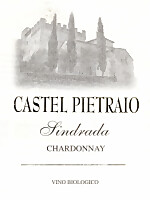
|
|
Sindrada 2020 |
|
| Fattoria di Castel Pietraio (Tuscany, Italy) | |
 Chardonnay Chardonnay | |
| Price: € 9.50 | Score: |
 Intense straw yellow and nuances of straw yellow, very transparent. Intense straw yellow and nuances of straw yellow, very transparent. Clean and pleasing, starts with hints of apple, citrus fruits and
banana followed by aromas of hawthorn, pear and plum. Clean and pleasing, starts with hints of apple, citrus fruits and
banana followed by aromas of hawthorn, pear and plum.
 Crisp attack and however balanced by alcohol, good body, intense
flavors. Crisp attack and however balanced by alcohol, good body, intense
flavors.
 Moderate persistence with flavors of apple, plum and banana. Moderate persistence with flavors of apple, plum and banana. Aged in steel tanks. Aged in steel tanks. |
|
 Vegetable appetizers, Risotto with vegetables, Sauteed fish Vegetable appetizers, Risotto with vegetables, Sauteed fish |
|
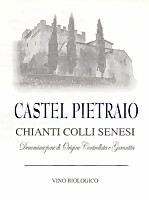
|
|
Chianti Colli Senesi 2019 |
|
| Fattoria di Castel Pietraio (Tuscany, Italy) | |
 Sangiovese (95%), Canaiolo Nero (5%) Sangiovese (95%), Canaiolo Nero (5%) | |
| Price: € 9.50 | Score: |
 Brilliant ruby red and nuances of garnet red, moderate transparency. Brilliant ruby red and nuances of garnet red, moderate transparency. Intense, clean and pleasing, starts with hints of black cherry, plum
and rose followed by aromas of violet, raspberry and blueberry. Intense, clean and pleasing, starts with hints of black cherry, plum
and rose followed by aromas of violet, raspberry and blueberry.
 Properly tannic attack and however balanced by alcohol, good body,
intense flavors. Properly tannic attack and however balanced by alcohol, good body,
intense flavors.
 Persistent finish with flavors of black cherry, plum and raspberry. Persistent finish with flavors of black cherry, plum and raspberry. 6 months in cement tanks, at least 6 months in bottle. 6 months in cement tanks, at least 6 months in bottle. |
|
 Stuffed pasta, Broiled meat and barbecue, Sauteed meat Stuffed pasta, Broiled meat and barbecue, Sauteed meat |
|
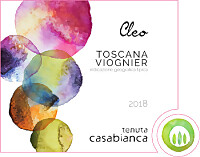
|
|
Cleo 2018 |
|
| Tenuta Casabianca (Tuscany, Italy) | |
 Viognier Viognier | |
| Price: € 15.00 | Score: |
 Brilliant straw yellow and nuances of straw yellow, very transparent. Brilliant straw yellow and nuances of straw yellow, very transparent. Intense, clean, pleasing and refined, starts with hints of peach,
citrus fruits and pineapple followed by aromas of broom, mango, pear,
apple, plum, banana, hazelnut, mineral and hints of vanilla. Intense, clean, pleasing and refined, starts with hints of peach,
citrus fruits and pineapple followed by aromas of broom, mango, pear,
apple, plum, banana, hazelnut, mineral and hints of vanilla.
 Crisp attack and however balanced by alcohol, good body, intense
flavors, agreeable. Crisp attack and however balanced by alcohol, good body, intense
flavors, agreeable.
 Persistent finish with flavors of peach, pineapple and mango. Persistent finish with flavors of peach, pineapple and mango. 6 months in barrique and steel tanks. 6 months in barrique and steel tanks. |
|
 Pasta with fish, Sauteed white meat, Fried fish, Stewed fish Pasta with fish, Sauteed white meat, Fried fish, Stewed fish |
|
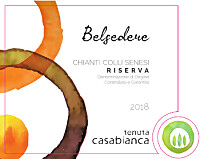
|
|
Chianti Colli Senesi Riserva Belsedere 2018 |
|
| Tenuta Casabianca (Tuscany, Italy) | |
 Sangiovese Sangiovese | |
| Price: € 18.00 | Score: |
 Intense ruby red and nuances of garnet red, little transparency. Intense ruby red and nuances of garnet red, little transparency. Intense, clean, pleasing and refined, starts with hints of black
cherry, plum and dried violet followed by aromas of dried rose, blueberry,
raspberry, carob, tobacco, vanilla and menthol. Intense, clean, pleasing and refined, starts with hints of black
cherry, plum and dried violet followed by aromas of dried rose, blueberry,
raspberry, carob, tobacco, vanilla and menthol.
 Properly tannic attack and however balanced by alcohol, good body,
intense flavors, pleasing roundness. Properly tannic attack and however balanced by alcohol, good body,
intense flavors, pleasing roundness.
 Persistent finish with flavors of black cherry, plum and blueberry. Persistent finish with flavors of black cherry, plum and blueberry. 24 months in barrique, 6 months in bottle. 24 months in barrique, 6 months in bottle. |
|
 Broiled meat and barbecue, Roasted meat, Stewed meat with mushrooms, Cheese Broiled meat and barbecue, Roasted meat, Stewed meat with mushrooms, Cheese |
|
|
||||||||
|
DiWineTaste Polls
|
| |||||||
Privacy Policy | |||||||


| Copyright © 2002-2024 Antonello Biancalana, DiWineTaste - All rights reserved |
| All rights reserved under international copyright conventions. No part of this publication and of this WEB site may be
reproduced or utilized in any form or by any means, electronic or mechanical, without permission in writing from DiWineTaste. |